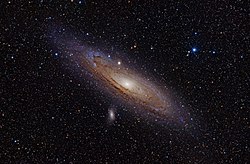NGC 185
| Galaxie NGC 185 | |
|---|---|
 | |
| Aufnahme des zentralen Bereichs mithilfe des Hubble-Weltraumteleskops | |
| AladinLite | |
| Sternbild | Kassiopeia |
| Position Äquinoktium: J2000.0, Epoche: J2000.0 | |
| Rektaszension | 00h 38m 58,0s[1] |
| Deklination | +48° 20′ 15″[1] |
| Erscheinungsbild | |
| Morphologischer Typ | dSph/dE3 / LINER / Sy2[1] |
| Helligkeit (visuell) | 9,3 mag[2] |
| Helligkeit (B-Band) | 10,3 mag[2] |
| Winkelausdehnung | 9′,5 × 7′,5[2] |
| Positionswinkel | 35°[2] |
| Flächenhelligkeit | 13,7 mag/arcmin²[2] |
| Physikalische Daten | |
| Zugehörigkeit | Lokale Gruppe Andromeda-Untergruppe Messier 31-Gruppe LGG 11[1][3] |
| Rotverschiebung | −0,000674 ± 0,000010[1] |
| Radialgeschwindigkeit | (−202 ± 3) km/s[1] |
| Hubbledistanz H0 = 73 km/(s • Mpc) | (2 ± 1) · 106 Lj (0,722 ± 0,269) Mpc [1] |
| Absolute Helligkeit | −15,8 mag |
| Durchmesser | 7.500 Lj[4] |
| Geschichte | |
| Entdeckung | Wilhelm Herschel |
| Entdeckungsdatum | 30. November 1787 |
| Katalogbezeichnungen | |
| NGC 185 • UGC 396 • PGC 2329 • CGCG 550-009 • MCG +08-02-010 • IRAS 00362+4803 • 2MASX J00385796+4820145 • GC 90 • H II 707 • h 35 • LDCE 31 NED004 | |
NGC 185 ist eine elliptische Zwerggalaxie mit aktivem Galaxienkern in der Lokalen Gruppe und ist schätzungsweise 2,3 Millionen Lichtjahre von der Milchstraße entfernt. Sie ist eine Begleitgalaxie des Andromedanebels und bildet zusammen mit NGC 147 ein gravitativ gebundenes Galaxienpaar.
Das Objekt wurde am 30. November 1787 von Wilhelm Herschel entdeckt.[5]
Literatur
- König, Michael & Binnewies, Stefan (2019): Bildatlas der Galaxien: Die Astrophysik hinter den Astrofotografien, Stuttgart: Kosmos, S. 292
Weblinks
- SIMBAD Astronomical Database
- Lokale Gruppe (Memento vom 25. Januar 2008 im Internet Archive)
- CDS Portal
Einzelnachweise
Auf dieser Seite verwendete Medien
Autor/Urheber: Roberto Mura, Lizenz: CC BY-SA 3.0
Caldwell Catalogue objects.
Autor/Urheber: NASA Hubble Space Telescope, Lizenz: CC BY 2.0
Located in Cassiopeia, not far from Caldwell 17, Caldwell 18 is a dwarf galaxy and a satellite of the Andromeda galaxy. Also known as NGC 185, it is a member of the Local Group of galaxies. Caldwell 17 is notable for its active galactic nucleus, a region at the center of the galaxy that emits extreme radiation over part of the electromagnetic spectrum.
Some astronomers classify Caldwell 18 as a type II Seyfert galaxy. These types of galaxies appear intensely bright when observed at infrared wavelengths despite their unremarkable brightness in visible wavelengths. Although the classification of Caldwell 18 remains up for debate within the astronomical community, if it is indeed a Seyfert galaxy, then it would be the only one known in the Local Group and the closest one to Earth.
Caldwell 18 was discovered in 1787 by the British astronomer William Herschel (who also discovered the planet Uranus). It is visible from the Northern Hemisphere in the autumn and from northern latitudes of the Southern Hemisphere in the spring. With an apparent magnitude of 9.2, this galaxy can be found with powerful binoculars. Caldwell 18 is easier to spot than the neighboring Caldwell 17, because its center appears more circular and compact than that of its neighbor.
This Hubble image combines observations taken with Hubble’s Wide Field Camera 3 in visible and infrared wavelengths. Clouds of dust appear near the galaxy’s center, and a globular star cluster appears to the left. These Hubble observations helped astronomers study the characteristics of globular clusters in nearby dwarf galaxies.
Credit: NASA, ESA, and A. Ferguson (University of Edinburgh, Institute for Astronomy); Processing: Gladys Kober (NASA/Catholic University of America)
For Hubble's Caldwell catalog website and information on how to find these objects in the night sky, visit: <a href="https://www.nasa.gov/content/goddard/hubble-s-caldwell-catalog" rel="noreferrer nofollow">www.nasa.gov/content/goddard/hubble-s-caldwell-catalog</a>Autor/Urheber: Adam Evans, Lizenz: CC BY 2.0
Die Andromedagalaxie ist eine Spiralgalaxie im Sternbild Andromeda (etwa 2,4 bis 2,9 Millionen Lichtjahre entfernt). Das Foto zeigt auch die Messierobjekte 32 und 110 sowie NGC 206 (eine helle Sternassoziation in der Andromedagalaxie) und den Stern ν Andromedae. Kombination von LRGB- und Hα-Bilddaten.




